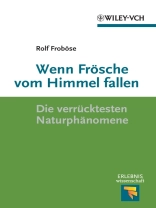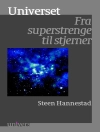As incredible as it may sound, nature is still unbeatable and provides us with the most amazing inventions and phenomena, beyond human imagination. Bacteria that produce plastic or electricity, for example, or natural rocket propulsion or algae that may meet the energy needs of future generations with their supplies of hydrogen.
How is it that frogs and fish fall from the sky, how does the dust from the Sahara reach the Caribbean and what lies behind the mysteries of the deep-sea methane oases? Yet nature has also invented modern technologies. A natural solar power plant, for example, provides an Antarctic lake with an agreeable water temperature, and the first functioning nuclear reactor existed in Africa two billion years ago. Nature even created the very first laser.
Researchers around the globe are increasingly searching for ways of using nature’s inventions for developing new products and concepts. One case in point are extremophile bacteria, which thrive at the baking temperature of 140 degrees Celsius. The resulting enzymes should prove fruitful in chemistry. But also chemosensors, which work like a dog’s nose, and bulletproof jackets based on spiders’ webs are visions that could profit from evolution’s treasure trove.
Daftar Isi
Exotische Mikroben –
Außenseiter der Evolution
Manche mögen’s heiß
Immer schön cool bleiben
Leben unter Druck
Von Kopf bis Fuß auf Ionen eingestellt
Leben im Atomreaktor
Sauer macht Ferroplasma lustig
Guten Appetit… auf TNT und Dioxin
Steinreich: Endolithe
Eine Turboalge produziert Wasserstoff
Thiomargarita namibiensis, das Riesenbakterium
VON KUGELBLITZEN UND LOCHKRISTALLEN
Rätselhafte Kugelblitze
Natürliche Raketen
Neue Sprengkraft für die Senfölbombe
Das große Zittern
Der erste Wärmesupraleiter
Kristalle aus Löchern
ATMOSPHÄRENSCHAUSPIELE UND WETTERKAPRIOLEN
Polarlichter – das himmlische Theater
Wenn nachts die Wolken leuchten
Tip, Katrina und andere Wirbelstürme
In jeder Hinsicht außergewöhnlich: Die Hurrikansaison 2005
Tornados versetzen keine Berge, aber Häuser
Wenn im Hochsommer Eis vom Himmel fällt
Saharastaub in der Karibik
Begegnung mit dem Teufel
GEOLOGISCHE UND GEOGRAPHISCHE WUNDER
Oasen in der Antarktis
Erstaunliches vom Meeresgrund
Tsunamis, die Monsterwellen
Total versalzen: Extreme Gewässer
NANOTECHNIK UND HOCHLEISTUNGSWERKSTOFFE
Nanodiamanten als verborgene Schätze im Erdöl
Der Lotuseffekt – eine Laune der Natur?
Wie Geckos senkrecht über Glasscheiben laufen
Der Fußball, der aus dem Kosmos kam
Glasfasern: Die Natur erfand sie vor vielen Millionen Jahren
Bakterien als Kunststofffabrik
Schwer auf Draht: Bakterien produzieren elektrische Leitungen
Vom Spinnenfaden zur schusssicheren Weste
RÄTSELHAFTE ENERGIEQUELLEN
Ein Solarkraftwerk in der Antarktis
Der erste Kernreaktor
Natürliche Laserquellen
WEITERE SELTSAMKEITEN DER NATUR
Kein alter Adel, aber blaues Blut
Ein guter Riecher: Die Hundenase
Wandelndes Chemielabor: Der Bombardierkäfer
Tintenfische als ‘Anti-Terror-Elite’
Schneller, höher, dicker
LERNEN WIR TRÄUMEN: EIN KURZES NACHWORT
Tentang Penulis
Following his studies in chemistry in Gottingen, Dr. Rolf Frobose worked as a scientists at the Max-Planck-Gesellschaft, was an editor at the technology magazine ‘high Tech’ and editor-in-chief of the journals ‘Chemische Industrie’ and ‘Europa Chemie’. Since 1995 he has been reporting as a freelance scientific and economic journalist on topics from the worlds of research and technology. He has written several popular science books, including the Wiley-VCH ‘Lust und Liebe – alles nur Chemie?’.












